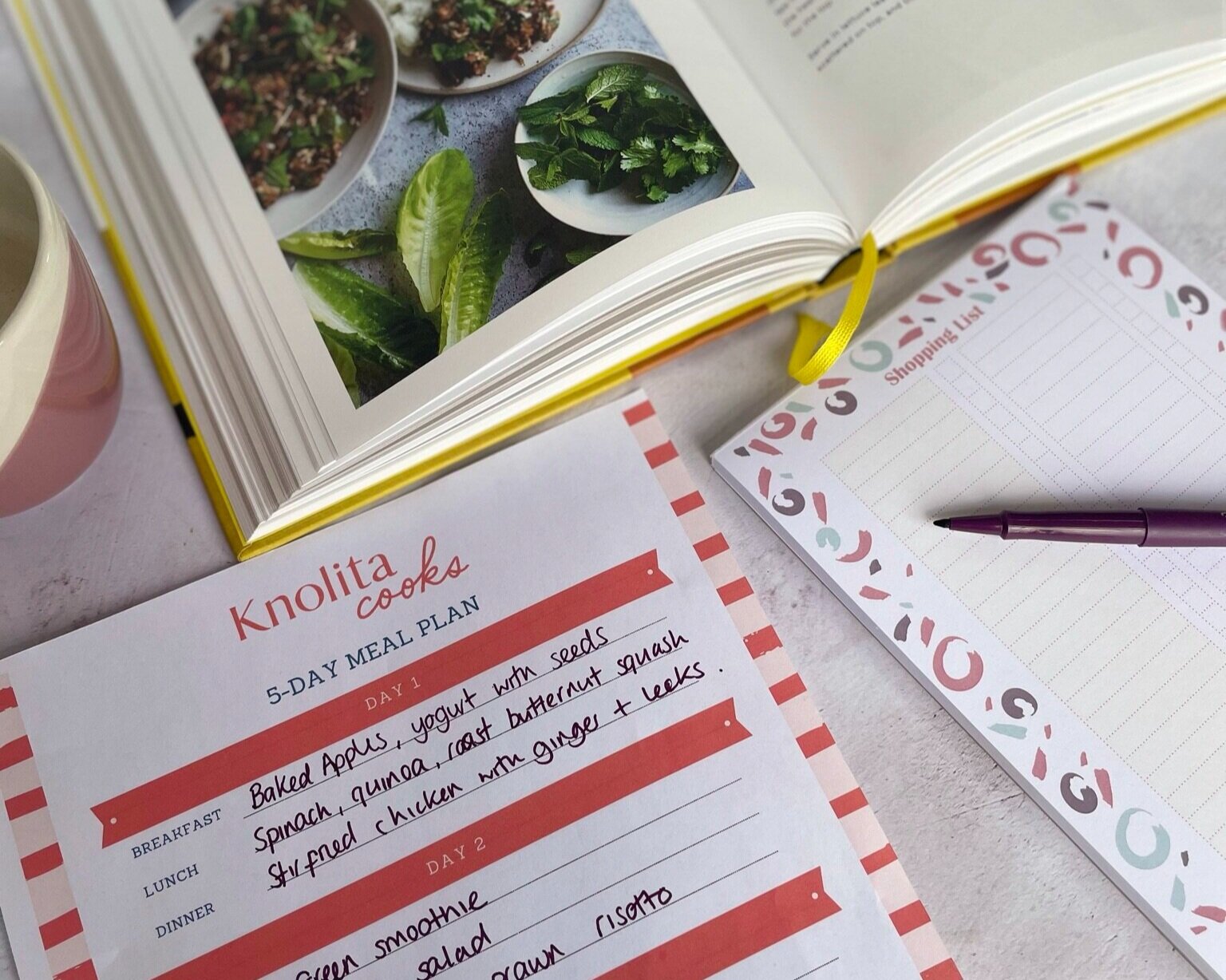How to meal plan – 4 step beginner’s guide
What is meal planning?
Meal planning is like asking ‘what’s for dinner?’ once for the whole week, instead of every night, and then shopping for and prepping the ingredients before cooking. The simplest way to start meal planning is to follow these four steps.
1. Select your dinners and their recipes
2. Shop for ingredients.
3. Prepare those ingredients.
4. Storage
I’m a fan of putting this practice into place over the weekend, planning on Friday, shopping on Saturday, and then sometime on a Sunday for meal prep. If you’re an online shopper start the planning earlier in the week and try and get your food order delivered in time for the weekend.
Meal planning misconceptions:
• Entirely home cooked: plan for takeaways, eating out, and leftovers.
• Only for families: If you’re on your own, these principles still work and be helpful.
• Expensive: You will save you money in the long run.
• Time consuming: Granted you’ll need to do some prep at the weekend, but you shouldn’t spend hours in the kitchen. Well unless you love cooking as much as I do!
Choose your recipes
Good meal planning starts with choosing your recipes. It’s the most critical step since it sets this whole process in motion. Don’t just choose a bunch of recipes and hope for the best. Start thinking about your meal plan at least three days before you want to give it ago so you have a few days to go through the full process of making a shopping list, shopping, and then prepping. Here’s how we recommend you pick your recipes.
Have a look at your calendar for the coming week and decide the number of nights you want to make dinner at home.
5 nights is the most common number, but if you’re trying this for the first time then aim for 3 so it’s not overwhelming.
On the nights that you’re cooking, what do those meals need to do? For example, on the nights that your kids have afterschool activities, then a slow cooker recipe is a good idea or a quick pasta ready in 20mins. If it’s just you and you’re working late, then something that you can also bring as tomorrow’s lunch.
Where to find recipes?
Endless choices from free supermarket magazines, to cookbooks, the internet and social media, there’s no shortage of recipe inspiration.
Here’s some things to consider when sourcing recipes.
• Choose meals that bless you with leftovers:
• Cook recipes you know + one new recipe:
• Pick recipes based on common ingredients:
• Cook things you really want to eat:
Your shopping list
Okay, you’ve decided on your recipes. Well done, you! Now think about what do you need to make them?
Firstly, write down all the ingredients you’ll need for the week’s recipes. Then do an inventory of what you already have in your, fridge, freezer, and store cupboards, cross them off the list. This is a great way to avoid over buying and food waste. You can find out more about store cupboard and freezer essentials on my blog.
Make the grocery list: You’re now ready to create your shopping list, try grouping ingredients together by departments in the grocery store (e.g fruit and veg). Top tip: Leave the frozen section for the end.
Right, you’re ready to shop, don’t forget those reusable bag before you head to the supermarket!
Spend an hour on Sunday prepping
You’ve completed steps 1 & 2, you’ve come to the point where the plan truly becomes dinner. But there’s one more step — and this one will help you beat cooking fatigue during the week do some prep! I recommend you set aside an hour or so on Sunday for batch cooking and chopping.
What you should do depends on the recipes for the week, but dicing up garlic, chopping veggies, washing lettuce and herbs, and even cooking up some chicken thighs or batch cooking a good ragú ahead of time is always a massive help.
Storage
The last thing you need to do before you put your feet up and is to store what you’ve prepped, remember your freezer is your friend, make sure you have some room in there to store portions of batch cooked food, especially pasta sauces, soups, traybakes and stews. Meanwhile store any chopped veg etc in the fridge in tupperware or invest in some reusable silicone bowl lids (a great way to save using clingfilm and reduce single use plastics.)
Round of applause you did it!
Meal planning is not difficult, but it takes some practice especially when you’re new to it. Every time you go through the process of meal planning you learn what not to do, the what you can improve upon on next week, what you can skip, and how to modify the process to fit your needs. Continuing to do it only makes you better.


